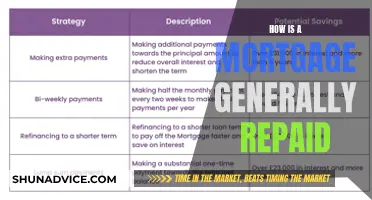
When a homeowner dies, their debts are typically paid from their estate. However, mortgage debt is treated differently. Unless there is a co-signer or co-borrower on the loan, no one is legally obligated to continue paying off the mortgage. If the deceased has an outstanding mortgage, the loan still must be repaid. In most cases, the mortgage debt is paid out of the estate or by the person who inherits the home. The heir can either continue making the mortgage payments or sell the home and repay the loan from the proceeds.
| Characteristics | Values |
|---|---|
| What happens to the mortgage after the borrower dies? | The mortgage debt is paid out of the borrower's estate or by the person who inherits the home. |
| Who inherits the home? | The home is inherited by the borrower's spouse, children, or other relatives. |
| What if the borrower has a reverse mortgage? | The loan amount is due after the borrower's death. The heir must repay the loan, sell the home, or turn the deed over to the reverse mortgage servicer. |
| What if there is no will? | If the borrower dies without a will, the courts appoint an executor to distribute their assets and liabilities. The executor may use outstanding assets or death benefits from a life insurance policy to pay off the mortgage. |
| What if the heir cannot afford the mortgage payments? | The heir may be able to refinance the mortgage to make it more manageable or sell the home and use the proceeds to pay off the loan. |
| What if there are multiple heirs? | The heirs may decide to sell the home or one heir may buy out the others and assume sole responsibility for the mortgage payments. |
| What if the heir does not want the home? | The heir can let the lender foreclose and repossess the home, but this may have tax consequences for the estate. |
| How can borrowers protect their heirs? | Borrowers can purchase mortgage protection insurance (MPI) or traditional life insurance to provide funds to pay off the mortgage after their death. |
What You'll Learn

The mortgage is paid from the estate or by the inheritor
When someone dies, their debts are paid from their estate. If there isn't enough money in the estate to cover the mortgage, the debt may go unpaid. The mortgage debt is typically paid out of the deceased's estate or by the person who inherits the home.
If the deceased had a will, this document will specify who inherits the property. If there is no will, state law determines who gets what, and the court will appoint an executor to distribute assets and liabilities. The executor might use outstanding assets or death benefits from a final expenses life insurance policy to pay off the mortgage.
If the inheritor decides to keep the home, they will need to continue making mortgage payments or sell the home and repay the loan from the sale proceeds. The inheritor can also buy out the other heirs to assume ownership of the property. However, this will make them solely responsible for all mortgage payments.
If the inheritor does not want to keep the home, they can let the lender foreclose. After a period of time with no payments, the lender will foreclose and repossess the home. However, foreclosure can have tax consequences for the estate.
It is important to notify the mortgage lender of the borrower's death as soon as possible. The lender can then communicate the next steps and provide information about the loan.
Understanding DTI: The Key to Unlocking Your Dream Mortgage
You may want to see also

The inheritor can sell the home to pay off the loan
Inheriting a home can be a blessing or a burden. If you've inherited a house with a mortgage, you'll need to make some crucial decisions. One option is to sell the home to pay off the mortgage. This is especially relevant if the value of the home is less than the outstanding mortgage debt, meaning the home has negative equity or is "underwater". In this case, the heir may decide to cut their losses and sell the home.
If you plan on selling, you'll need to use the proceeds to pay off the remaining loan balance. When several people inherit a home, the easiest course of action is often to sell it to pay off the mortgage and split any remaining proceeds. If one beneficiary wants to keep the home, they may have to buy the other beneficiaries' shares of the property.
If you decide to sell, you can list the home for sale just like you would a home you purchased yourself. The home is yours as soon as the deed has been transferred to you. You can sell the home for 95% of the appraised value. However, you'll need to notify the mortgage company of the death as soon as possible, and provide a death certificate, so that you can verify the outstanding balance of the mortgage.
If you don't want the house and don't want to sell it, you can simply take no action. After a period of time with no payments, the lender will foreclose and repossess the home. However, foreclosure can have tax consequences for the estate, so it's important to contact an accountant or attorney before going down this route.
HECM Mortgage: Death of Owners, What's Next?
You may want to see also

Life insurance can be used to pay off the mortgage
Life insurance can be used to pay off a mortgage after the policyholder's death. This is known as mortgage protection insurance (MPI) or mortgage life insurance. It is a type of term life insurance policy designed to pay off the remaining mortgage debt and associated costs in the event of the borrower's death. The death benefit is paid directly to the mortgage lender, and the coverage amount is usually tied to the outstanding mortgage principal. This ensures that the policyholder's dependents can retain possession of the family home without the burden of mortgage payments.
Mortgage life insurance policies are often offered by banks or mortgage lenders, but they can also be purchased from unaffiliated insurers. The coverage period typically matches the term of the mortgage, usually 15 or 30 years, and the death benefit amount may be structured in a few different ways. One option is a decreasing term policy, where the death benefit decreases over time to match the rate at which the mortgage is paid off. Another option is to tie the death benefit to the outstanding mortgage principal, ensuring that the coverage amount reflects the current balance of the loan. Level term insurance, where the size of the policy remains constant, may be suitable for borrowers with interest-only mortgages.
It is important to note that mortgage life insurance differs from traditional life insurance policies in that the lender is the beneficiary, not the policyholder's spouse or chosen beneficiary. Additionally, mortgage life insurance may be tied to the home, requiring a new policy if the insured moves, or bundled as part of the mortgage, making it difficult to cancel. Term life insurance policies, on the other hand, offer greater flexibility and are generally more affordable, especially for healthy, nonsmoking individuals.
While mortgage life insurance can provide peace of mind and ensure financial stability for the policyholder's family, it is not the only option for protecting one's dependents in the event of death. Traditional life insurance policies can also be used to pay off mortgage debts, and they offer more flexibility in terms of designating beneficiaries. Additionally, creating a comprehensive estate plan, including a last will and testament, can help outline the policyholder's wishes and prevent confusion or conflict among family members.
Creating a Legal Mortgage: Understanding the Process and Requirements
You may want to see also

The surviving spouse can assume the mortgage
When a homeowner dies, the inheritance of their home is typically decided by a will or probate proceedings. If the home has a mortgage on it, the mortgage debt is generally paid out of the deceased's estate or by the person who inherits the home. The heir can either continue making the mortgage payments or sell the home and repay the loan from the sale proceeds.
Federal law allows a surviving spouse to assume the mortgage and keep the home, as long as they meet certain criteria. The Garn-St. Germain Depository Institutions Act of 1982 prevents mortgage companies from enforcing due-on-sale provisions in certain situations, including when a surviving spouse inherits the property. The Consumer Financial Protection Bureau (CFPB) has also enacted rules that guarantee surviving spouses the same rights as the original borrower, including the ability to assume the mortgage (take over payments).
If you are a surviving spouse who wants to assume your partner's mortgage, you must be able to afford the mortgage payments. If you can't, you may need to apply for a loan modification. You will need to contact the mortgage lender or servicer to find out about the next steps and information. Ask about the outstanding balance, the monthly payment, and other essential details. You will likely need to provide a certified copy of the borrower's death certificate and potentially their will.
It's important to note that the rules may change if you inherit a home from someone other than a spouse with whom you are a co-borrower on the home's reverse mortgage. In this case, the loan amount is due after the borrower's death, and if you want to keep the property, you must repay the loan.
Mortgages: Put Option-Like Security for Homeowners
You may want to see also

The mortgage lender must be notified of the death
The death of a loved one can be a difficult time, and managing their affairs can be challenging and confusing. One of the first steps to take is to notify the mortgage lender of the death as soon as possible. This is crucial and can prevent future complications, such as accumulated late fees, missed payments, or the risk of foreclosure.
To notify the mortgage lender, there is a formal process to follow. While some lenders may have specific procedures, there are several general steps that are common among them. Firstly, prepare a formal letter informing the mortgage company of the borrower's death, including the deceased's name, address, date of death, and mortgage or account number. This provides the lender with official documentation.
Secondly, a death certificate must be supplied to the lender to confirm the death. If the deceased had a will and named an executor, the lender will require documents affirming the executor's designation. In cases without a will, an administrator appointed by the court can deliver the necessary documents. It is also essential to provide proof of your right to the property, such as a deed to the house.
Finally, deliver the contact information of the person handling the deceased's estate to the mortgage lender. This person could be the executor of the will or an administrator appointed by the court. It is important to keep in mind that each state has different rules regarding title transfers, so consulting an attorney to understand your specific state's laws is recommended.
Once the mortgage lender has been notified, they will guide you through the process of assuming the loan, which can vary depending on the institution. Lenders will require individuals assuming the mortgage to meet the "ability to pay" requirements. At this stage, it is essential to discuss options for continuing payments and any potential modifications to the mortgage to avoid foreclosure if desired.
Creating Collateralized Mortgage Obligations: A Step-by-Step Guide
You may want to see also
Frequently asked questions
The mortgage debt is generally paid out of the borrower's estate or by the person who inherits the home. The heir can either continue making the mortgage payments or sell the home and repay the loan from the sale proceeds.
If there was a reverse mortgage on the property, the loan amount is due after the borrower's death. If an heir wants to keep the property, they must repay the loan. Otherwise, they can sell the home or turn the deed over to the reverse mortgage servicer to satisfy the debt.
Life insurance can provide heirs with a lump sum to pay off the mortgage. It can also be used to cover other expenses, such as medical bills and funeral costs.
Federal law provides protections allowing the surviving spouse to assume the mortgage and keep the home, as long as they inherit the property and can afford the payments.
If there are multiple heirs and no one wants to keep the property, selling the home is an easy solution. If one heir wants to keep the property, they can buy out the other heirs, but this will make them solely responsible for all mortgage payments.







